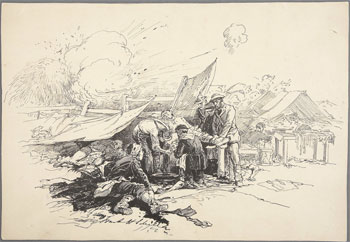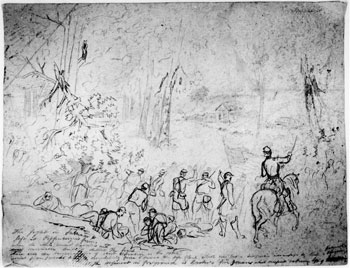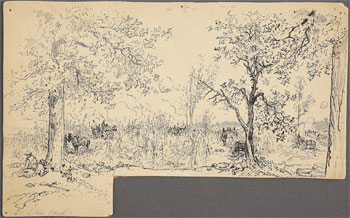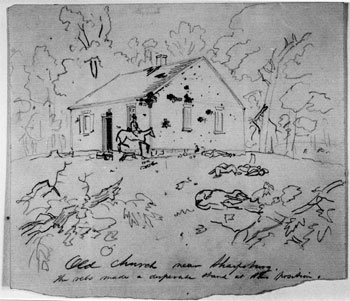Frank Schell’s battle
17 January 2010
Frank Schell accompanied the Army of the Potomac on the Maryland Campaign of 1862, and was on the field for the battle on 17 September. He was a civilian there from New York – a sketch artist for Frank Leslie’s Illustrated Newspaper.
Fortunately for those who study the battle, a number of his original battlefield sketches have survived. I’ve recently discovered a set sold at auction in 2007, and a group preserved in a collection at Boston College, in particular. I’ve grabbed some selected gems among them to use here.
Even better, in 1904 Schell published his recollection of the events that were going on around him as he was drawing these same pictures. So in sharing his pictures and his superb eye, I can also leave the writing to Frank – to narrate his own drawings and give us a sense of his Battle of Antietam.


Hooker’s Corps crosses the Antietam (16 September 1862, pub. Leslie’s 11 Oct 1862)
As I awoke soon after daylight on the morning of September 17, 1862, the air was already vibrating with mighty sounds of battle … With spirits aflame, I speeded at my best from Keedysville for the headquarters of the commanding general … I joined the group about the commanding general, who was anxiously scanning through his field glass the situation to the right, across the Antietam. Looking more to the left, the thick west wood, with its dark, broad front so clearly emphasized by the little white Dunker church, was clearly in view along its entire extent upon the Hagerstown turnpike.
General McClellan suddenly lowered his glass, and, with a few animated words and expressive gestures, called Porter’s attention to something that caused an immediate ferment of buzzing excitement throughout the group and a close scrutinizing of the bit of woodland, for the time being, the focus of such absorbing interest …
I leveled my glass in the general direction and saw innumerable glints of light reflected from a long line of gun-barrels at the edge of the wood, which quickly passed to a great field of tall corn above the top of which the coruscating line began to advance.
Soon, out rushed a broken Confederate force from the corn-field across the open ground toward the Dunker church wood, into which, after some halting and sporadic firing in vain resistance, it finally disappeared from view. But onward through the ripened corn the Yankee line pushed its way; its position and direction beautifully indicated by the National and regimental colors gaily waving above the corn-stalks, and by the sparkling flashes from gun-barrels and bayonets …
The exciting spectacle quickened a determination to see this furious battle from closer quarters. Following in the track of Hooker’s corps, which was easy to trace, I crossed the Antietam, and, climbing the hills beyond, soon reached a farm that was beginning to assume the functions of a hospital, and was at once among the unfailing symptoms of the rear of battle. Beside a fringe of timber was a farm already doing full duty as a field hospital, with a strangely pretty artistic effect of tents and tiny arbors grouped about its various buildings.
Hastily noting the distressing work of the surgeon’s knife and saw, I hurried away from its rueful accompaniment of shrieks and groans.


A field hospital at Antietam (17 September 1862, HA)
I came upon a great open space with woodland ahead, and, on the right, the heavy rearward drift, the chaotic jumble of retreating artillery and infantry, the profusion of picturesque material, always the accompaniment of hurried retreat, and the loud though decreasing sounds of battle at the front, were undeniable evidences of disaster. Though the sun shone bright and warm, a dark cloud of gloom now hung over this beautiful tract, and I stood for a time uncertain as to what to do or where to go, watching the flow of the ebb tide of battle bearing away its driftwood of defeat.
Then a broad belt of light flashed into the open and dispelled the disheartening forebodings. It gleamed from the bayonets of a column of fresh troops boldly advancing from the direction of the Antietam with a quick step and defiant air. At its head rode the grim and dauntless old Sumner with his staff and a small cavalry escort. There, too, was the intrepid “Uncle John” Sedgwick, about to lead this column of hope, the hitherto unbeaten “Second Division,” into battle to retrieve the awful mishap to Hooker. All were “full of ginger,” undaunted by the all-pervading evidences of rout.


Generals Sumner and Sedgwick (17 September 1862, HA)
… a shell exploded with terrifying report over the farm hospital I had sketched, sending its hissing fragments among the wounded and attendants, and causing such anxious commotion that I hastened back. Preparations were being made to locate it further to the rear. Twowheeled ambulances, coming up with their groaning passengers, were ordered “out the Smoketown road,” to the farm determined on for the removal.
Then, again, stillness came into the wood, through which I went, now without fear of a pistol shot or sabre slash, with the Hagerstown pike as my objective. I was troubled with a presentiment that Sedgwick and his division had met with the fate of Hooker, and I was anxious to learn the luck of the men who had proved their mettle on the bloody fields of the Peninsula, and had been subjected to this new crucial test of their prowess.


The Fight at Poffinberger’s [sic] Farm (17 September 1862, Becker)
Out in the open, to the rear of the woods, there was a drifting about of disorganized men, with shouting officers striving to get their commands together” about the regimental colors, planted in the ground or being waved in the air by cheering colorbearers. I heard my name shouted out, and met, near the solid farm buildings of D. R. Miller, then a crowded hospital, a young friend, a captain in the 72d Pennsylvania Regiment, of Sedgwick’s Division, who was with a knot of his men. He told me quickly the story of his regiment’s fight.
With the wood at my right. I closely skirted the corn-field, and came upon a battery of small Parrott guns at work amid the wreck of corn-stalks.


Vanneman’s Maryland Battery in the Cornfield (17 September 1862, HA)
Artillery in action was always a drawing card with me. and here was a fine chance to stop awhile and enjoy the stimulating attraction. The gunners, in shirt sleeves or bare arms, were working with an almost annoying deliberation. Their performance, too, was being, as it seemed, treated rather contemptuously by the enemy, for the replies to our “cartes de visite” were but few and at irregular intervals, a parsimony which was duly appreciated by the small but select audience present. Some of our heavier batteries to the right and rear, whose roar could be heard, were being more respectfully and liberally considered, the Confederate shells screaming over our heads and doing business in remoter quarters.
But we were not altogether neglected, as I saw two of the missiles from the west wood vicinity explode, one in the cornfield ; the other above it, wounding one of the battery horses. It was Vanneman’s Maryland Battery of the Sixth Corps, as I learned, to which I was indebted for this entertainment, which seemed to be enjoyed by the performers as well, though they were tormented with terrible thirsts.
It was about here that Hood’s Division of the Confederates and some of Hooker’s men fought so heroically in the gray of the morning, “tearing each other to pieces.” and the terrible evidences of the struggle lay around me plentifully.
I was tiring of this feast of horrors and, leaving the wood, was soon at D. R. Miller’s farm. On the Hagerstown pike, and on each side of it, were guns of Campbell’s Regular Battery, for the possession of which an audacious onslaught had been made an hour or more before by Jackson’s troops, who had rushed from the west wood and fought up to the very muzzles of the guns before they were put “to the right about” by the determined defense of Gibbon’s men from Wisconsin and Indiana, and Patrick’s Brigade of the First Corps, followed by a counter dash which almost annihilated the heroic charging column of the enemy.
There were curdling tales told me of this stubborn fight, where Confederate colors had been taken and prisoners captured. Here, too, were sharp contrasts. On the west side of the pike were Miller’s barn, haystacks, and mowing and threshing machines, in close communion with the openmouthed cannon and other implements of destruction. Could peace and war in juxtaposition be more impressively illustrated? The wheat was gathered in, the corn destroyed, and the crop of corpses and misery was being industriously harvested in all directions.


Old Church Near Sharpsburg (September 1862, Becker)
Notes
____________
Francis H. “Frank” Schell (1834-1909) had been an illustrator and lithographer in Philadelphia before going to New York and signing on with Frank Leslie as a ‘special artist’ in 1861. He was on the North Carolina Campaign earlier in 1862, then joined the Army of the Potomac just ahead of Antietam. He was later at Vicksburg, on the Gulf, and on the Atlanta Campaign. He had more than 200 of his war images printed in Leslie’s, and was the magazine’s art director after the war. He also published drawings in Century Magazine and in the Battles & Leaders compilation.
____________
All of the illustrations and description of the battle above are Frank Schell’s.
His narration is from Sketching Under Fire at Antietam, McClure's Magazine, Vol. XXII, February 1904, pp. 418-429. The full article is online from GoogleBooks, too. I extracted highlights, though maintaining his sequence, to accompany the pictures.
The bright (probably hand-colored) image at the top is from a drawing by Schell transformed by engravers and printed in Leslie’s. This one in the 11 October 1862 edition. The digital copy I use here is from the Antietam Battlefield website exhibit of newspaper drawings.
The Schell images in the Becker Collection (“Becker”) at Boston College are online. There are 56 of Frank Schell’s War drawings in the collection. Transcriptions of the artist’s notes (below) from the two I used are from that site:
The Fight at Poffinberger’s Farm; “The fight on Sumner’s left at Poffinberger’s Farm where the rebels covered themselves with every conceivable kind of shelter. The fight here was very sanguinary but of short duration as the rebels issued from the woods below in overwhelming force and turned the left flank, which was but a temporary advantage to them. The regiment in the foreground is Baxter’s Fire Zouaves which occupied extreme left of Sedgwick’s division. Battle of Antietam. Sept. 17, 1862.”
Old Church Near Sharpsburg; The Rebels Make a Desperate Stand at This Position
The three drawings above labeled “HA” were sold during a November 2007 auction hosted by Heritage Auction Galleries. They fetched nearly $12,000 – accompanied by a fourth unfinished work and pages from Schell’s McClure’s article.
Vanneman’s battery was Battery B, Maryland Light Artillery. Lieutenant Theodore Vanneman’s brief after-action report of their work is on AotW. As is a little more about Baxter’s Fire Zouaves (72nd Pennsylvania Volunteer Infantry).
__________
Same guy? Extra credit/later project: Frank was possibly born as early as 1830. A Francis H Schell was admitted to Central High School, Philadelphia in January 1843 at 12 years, 3 months of age (suggesting approximate birthdate of October 1830). He left Central in April 1844.


November 11th, 2010 at 12:28 pm
Brian–Thank you for posting Frank Schell’s battle. The images and narrative from Schell provides a new found depth to the narrative of the West Woods.
I am, however, curious about Schell’s drawing of the 72nd Pennsylvania. In it, the regiment is clearly opposite the Mary Grove Locher cabin where her tenant, Alfred Poffenberger and family resided on September 17.
Here is what I don’t understand: Documentary evidence places the 72nd down by the Dunkard Church. First, the map series prepared under the direction of the Antietam Battlefield Board and published in final edition in 1908, shows the 72nd split into two wings (“Right Wing” and “Left Wing”). The “Left Wing” is situated opposite the Dunkard Church; the “Right Wing” further north along the Hagerstown Pike. The map shows that the “Right Wing” retreated in a north east direction. The”Left Wing” has no retreat indicator. Second, we have documentary evidence from individuals in the 28th Pennsylvania that places the 72nd opposite the Dunkard Church near the intersection of the Smoketown Road with the Pike.
The question that Schell’s drawing raises is this: Where was the 72nd Pennsylvania that morning?
January 21st, 2011 at 2:01 pm
this is really great. Francis was my great great grandfather, i believe not sure how many greats are in there. i’d love to know more about him.
June 18th, 2011 at 1:31 pm
I recently published a historical narrative on the First Minnesota that includes all 218 letters of my Great Grandfather that fought in that regiment. At Antietam they were on the extreme right wing of the Union army and fought in the East Woods, crossed the cornfield, went into the West Woods and were the last to withdraw. He mentions several regiments that were overwhelmed and withdrew leaving them surrounded on 3 sides.
August 18th, 2018 at 4:47 pm
I really enjoyed the piece, and I was wondering how Schell worked with the editors at F. Leslie’s to determine what sketches were ultimately published. I assume that most of his work remained hidden to the public. I would appreciate any insights into this matter.
Warmest regards, Pete
August 19th, 2018 at 3:46 pm
Hi Pete, I hope we’ll get some information back on that question here, but I’ll also put it out to some larger groups. Interesting!
August 21st, 2018 at 9:09 pm
Fiona Halloran kindly replied to this on the AotW Facebook page: